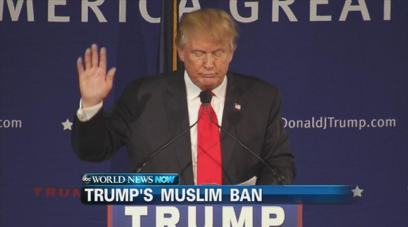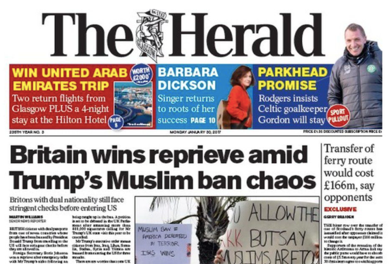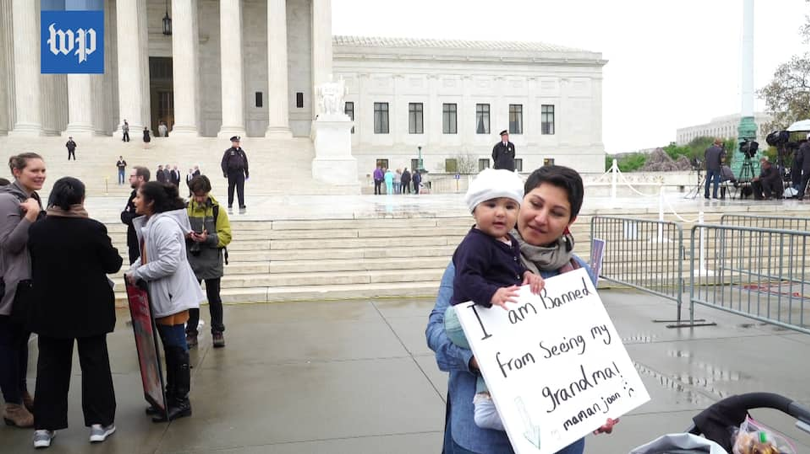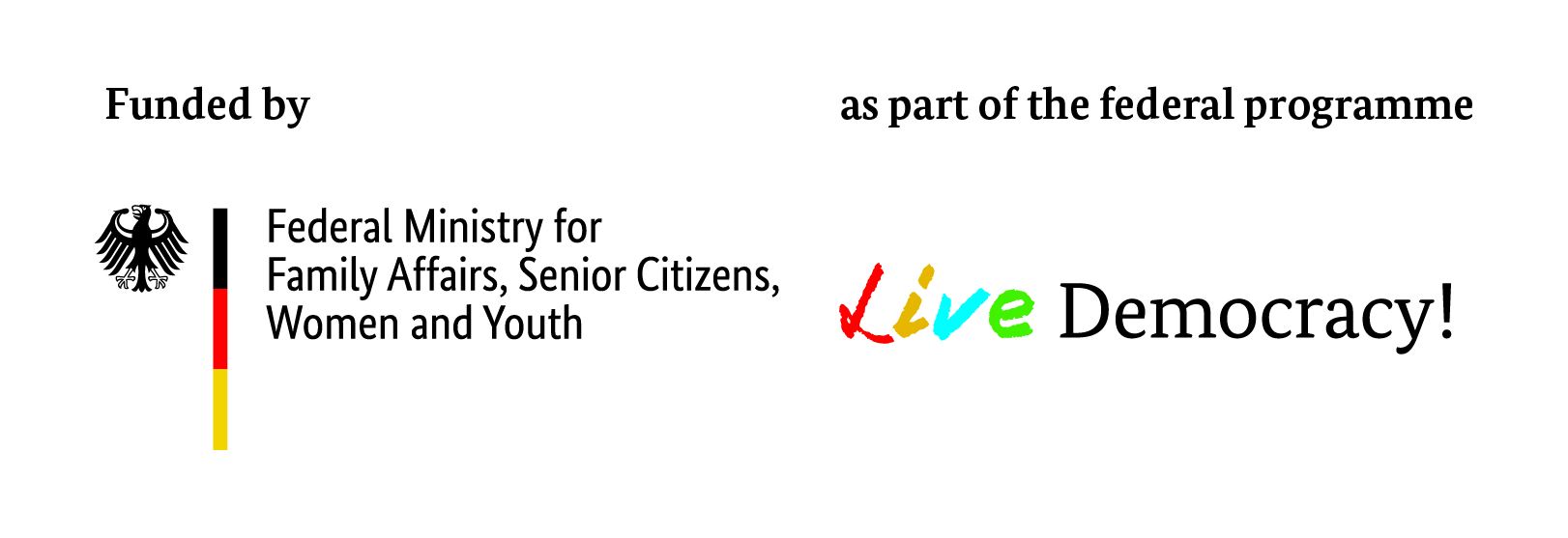Winning the narrative space around the Muslim Ban: Lessons on how to achieve "presence" in the public debate
This case study highlights three lessons on how USA-based advocacy and movement building NGO ReThink Media advocated against Donald Trump’s 2017 “Muslim Ban” using narrative change and reframing as a key tool that kept the issue on the agenda and ultimately, prepared the ground for overturning the ban. Persevering to make your narrative one of the dominant narratives circulating in the public discourse means you can still win the narrative space, even if you lose your policy/legal objective. Advocates are rightly trained to see the legal/policy outcome as the ultimate point of victory or loss. But this case shows that if you continually build presence of your narrative in the public debate, you keep pressure on the opposition, highlight a clear mismatch between the law and public attitudes, and pave the way to overturn such a law in the future – and ultimately, achieve narrative power. And this is what happened when Biden came into office in 2021.
The announcement of Trump ‘s “Muslim Ban1 on January 27th, 2017 – that excluded foreign nationals from seven predominantly Muslim countries – caused widespread outrage and was a galvanising movement for progressive activists. For over four years, Rethink Media and a broad coalition of allies2 advocated against the Ban, the underlying laws used to create it, and anti-Muslim racism more generally. While the key 2018 Supreme Court decision to overturn Trump’s Executive Order was lost, activists still won the narrative space. Trump and his allies tried to frame the order as a “travel ban”, but the “Muslim Ban” framing was taken up by the public, political opposition and many media outlets around the world. Ultimately this meant that the framing supporting the progressive analysis of the order (implying an inherent rights infringement) set the agenda.3
More specifically, the goals and main milestones for the work of ReThink and their allies were:
-
Advocating against the Muslim Ban: in 2017 when the Executive Order was first declared and in 2018 when the Ban was challenged at the Supreme Court
-
Winning the narrative space and frame Trump’s Executive order as a “Muslim Ban”
-
Passing the NO BAN Act 4 - legislative proposal to prevent any further discriminatory executive orders (2018 – 2020)
-
Ensuring Joe Biden rescinded the Ban5 as soon as he entered office in early 2022
Defining presence
The narrative change work in this case was a focus on building presence of a key set of narratives challenging the Muslim Ban. From a strategic communications theory of change perspective, this means promoting narratives widely and persistently in public debate through media work and campaigns or put simply, getting your narrative known. As the definition implies, the work goes far beyond single campaigns or ad-hoc interventions, to a continual promotion and defence of target narratives, so that your narratives become the dominant stories circulating in the media space/public discourse. As this case shows, effectively building presence in the public discourse is a key stepping stone to building the public support and political will to change laws and policy and ultimately, achieve narrative power.
In our Strategic Communications theory of change model, a third, middle step is often needed and this is immersion. Immersion moves from getting your narratives known, to creating opportunities for them to be owned in communities. ICPA’s thinking has been inspired by Rashad Robinson, from Color of Change USA. Read more about the theory and it’s three guiding principles here.
Building presence to win the narrative space – Three key lessons
Three lessons stand out in this case about how a diverse network of activists promoted narratives widely and persistently in public debates – or achieved presence – in such a way that presence could act as a bridge to narrative power.


Examples of media outlets in the USA and UK naming the Executive Order a “Muslim Ban”. Uptake of this framing has been large: Even arguing “this is not a Muslim Ban” reifies the Progressive frame.
1) Seek unity, not uniformity in your coalition
If you want to sustainably build presence, harmonisation within your broad coalition of allies is needed. Frank Sharry from America’s Voice offers pithy advice when dealing with strategic communications coalitions: seek unity, not uniformity. Not surprisingly in a diverse network, there’s no one size fits all message. ReThink and their network ensured unity in narrative strategy but offered different messaging alternatives. For example, out of the four messages ReThink recommended for their coalition to adopt (see the table below), three were more oriented towards the supporter base (e.g. using “racism” frames) and one was targeted to "moveable middle” audiences (using the value frame of “religious freedom”).
| 1) Undoing Trump’s first racist act is a strong signal of unravelling his racism | 2) We are stronger as a nation when we defend religious freedom for all, a traditional hallmark of U.S. First Amendment rights, rather than when we give in to the president’s fear and division |
| 3) This is not an isolated policy, it is part of a broad campaign against immigrants and communities of colour. This is not okay. | 4) We want evidence-based security policy |
Four main message alternatives, within the broader “Muslim Ban” narrative strategy6
So, the big picture lesson is: you cannot expect everyone will be willing to say the same thing (uniformity), but there should be unity in narrative direction or target, with a variety of alternative messages so coalition members can choose messages that they feel most comfortable using and are the best fit for them.
2) Coherence leads to the coverage
Following on from lesson 1, ensuring unity of narrative strategy within strategic communications coalitions is a key building block for sustaining presence in the public debate because message coherence makes it easier for journalists to report on your agenda – rather than the opposition’s. For ReThink and their allies, achieving this coherence was a hands-on persistent process. Initially, protest messages seen outside during the Supreme Court Oral Arguments in April, 2018 were quite disparate. This message confusion was reflected in the media coverage: ReThink’s media analysis revealed that nine different progressive activist messages that were reported on – and had the effect of drowning each other out. This meant that initially, the opposition won the narrative space, as they focused on a smaller number of messages that were picked up more easily by reporters.
To bounce back and win the narrative space as Decision day approached (June, 2018), ReThink Media pushed to ensure that most players in their coalition were on the same messaging page. Through a significant investment into coffee meetings, ReThink repeatedly suggested the four key messages they predicted would work on the basis on extensive testing (see table above). Two months later, on Decision day (June, 2018), the protester messages outside the Court were much more streamlined (reducing from nine to five main messages – four of which were the messages ReThink recommended). This time, opposition were forced to be on the defensive and activists had won back the narrative space.

A protester using a values-based message about family.
The big takeaway of lesson 2 is that it’s worth investing in the hard work of mobilising your network and ensuring everyone is on the same messaging page in order to maximise the presence of your narrative in the public debate.
3) Presence is about persistently and proactively building voice, visibility, volume and surround sound in media spaces
As stated above, building presence is more than doing communications well or individual or ad hoc interventions. It’s about building a narrative that has continual visibility and volume in the public dialogue around the issue. This was achieved through four main activities:
-
First, Rethink and its allies developed a messaging strategy that considered the supporter and movable middle audiences needed to swing the balance of the debate and what would move those audiences.
-
In 2018, they extensively trained spokespeople in their network to use the recommended narratives (which not only led to a measured increased of “presence” in the public debate, but changed the tone of the public discourse as narratives became less negative and more positive between April and June 2018).
-
Third, they set up early and prepared for all outcomes. They made sure their network was ready for winning or losing the June 2018 Supreme Court judgement by pre-pitching to outlets and pre-writing op-eds ready for either outcome. By setting up the narrative early, opposition were forced to respond to their narrative in the public debate.
-
Fourth, they continually persevered towards their movement goal. They felt the overturning of the Ban as a political goal was still not enough: they wanted to ensure discriminatory bans like this would not happen again, and they created and advocated for the NO BAN Act (2020) which challenges the underlying laws used to create the Muslim Ban.
The bigger picture of lesson 3 is sticking at it for the long term: being persistent and proactive over a long period of time is important if you want to secure sustainable presence of your narrative in the public debate and get people to frame the issue on your terms.
Conclusion - by building presence, you can win the longer-term game despite losing the short-term objective
This case study shows us that you shouldn’t give up if you don’t immediately achieve your legal victory. If you persistently and proactively build presence of your narrative in the public debate, and make it one of the main narratives circulating, you can keep pressure on the opposition, highlight a clear mismatch between the law and public attitudes and “set the table” for the next political leader to enter office and see the overturning of the ruling as an easy win. And this is what happened! Biden rescinded the Order as soon as he entered office in January 2021. These three lessons give activists a taste of what it takes to build presence of new narratives in the public debate – and will hopefully inspire them to think in terms of presence, rather than communications, by investing in the long-term, hard work of shifting norms.
This case study was developed by the ICPA Strategic Communications Incubator team on the basis of an interview with Corey Saylor and Adrienne Varkiani of Rethink Media and analysis of internal and public documents pertaining to Rethink Media’s narrative change work on the Muslim Ban. Gratitude to Corey and Adrienne for generously sharing their experience and thinking.
The case study was developed in the framework of ICPA’s RESET project as part of a set of resources to support the strategic communications work of a network of German activists. Support for researching and developing the case study was provided by:


This publication does not express the opinions of BMFSFJ or BAFzA. The authors are solely responsible for the content of the publication.
- 1The official Executive Order is: Executive Order 13769, titled “Protecting the Nation from Foreign Terrorist Entry into the United States”, signed by President Trump Jan 27, 2017. URL - https://en.wikipedia.org/wiki/Executive_Order_13769. It will be referred to as the “Muslim Ban” hereafter
- 2E.g. American Civil Liberties Union, America’s Voice , Colour of Change, Open Society Foundations and many others
- 3Ironically but maybe not surprisingly, it was Trump himself that used the “muslim ban” framing during his electoral campaign."https://www.theguardian.com/us-news/2015/dec/07/donald-trump-ban-all-muslims-entering-us-san-bernardino-shooting
- 4The NO BAN Act limits future presidents’ authority to pass future travel bans using section 212(f) of the Immigration and Nationality Act. A vote for the Act, as a symbolic move to place it on the political agenda, was originally scheduled in Congress for March 2020. However, Covid-19 hit, and emergency planning was prioritised. But thanks to the persistent efforts of ReThink and their coalition, eventually, Biden inserted the NO BAN Act into the Immigration Bill he sent to Congress during his initial days in office.
- 5https://www.whitehouse.gov/briefing-room/presidential-actions/2021/01/20/proclamation-ending-discriminatory-bans-on-entry-to-the-united-states/
- 6See ReThink’s Messaging resource: 2020 Muslim Ban Messaging, August 2020https://rethinkmedia.org/resource/2020-muslim-ban-messaging?authkey=0cb8624cf89fbd1889cbdd969658a86785b48ad7aa15e382c93acc3a5de9d7bd